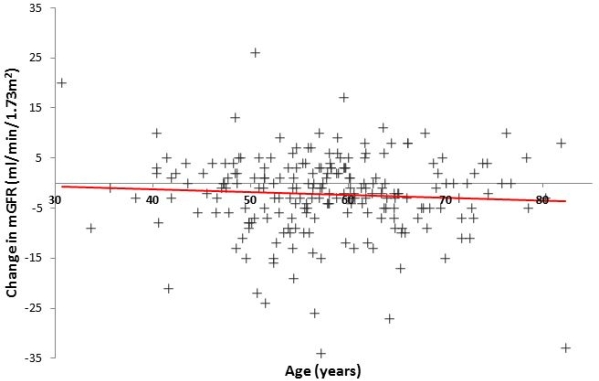Trajectory of Measured GFR Decades After Kidney Donation: Hyperfiltration Never Seems to End!
U of MN, Mpls.
Meeting: 2015 American Transplant Congress
Abstract number: 97
Session Information
Session Name: Concurrent Session: Kidney: Living Donor Issues I
Session Type: Concurrent Session
Date: Sunday, May 3, 2015
Session Time: 4:00pm-5:30pm
 Presentation Time: 4:00pm-4:12pm
Presentation Time: 4:00pm-4:12pm
Location: Terrace IV
While the effect of uninephrectomy on loss of GFR is a cardinal issue for potential kidney donors, current information relies on surrogates of unknown validity, such as those from creatinine-based estimating equations and urinary clearance methods.
Hence, a random sample of our donor population was selected to undergo serial iohexol GFR testing. Testing began in 2005 and participants were invited to return for repeat measurements every 3 years thereafter.
The mean age of the 214 donors with two GFR measurements was 52.9 ± 9.8 at the first GFR assessment, performed 12.1 ± 8.9 years after donation; 79% were related to the recipient and 61% female.
Median GFR was 70.5 (mL/min/1.73 m2) at the first assessment. In the 4.8±1.3 year interval between GFR assessments, GFR declined slowly, at a median (IQR) rate of -0.3 (-1.4, 0.6) per year. Overall, there was a 0.05 ml/min/1.73 m² decline in GFR for additional year of age (Figure 1).
In those with a decline in GFR, the rate was -1.6±1.5 ml/min/1.73 m²/yr, compared with +1.3±1.5 ml/min/1.73m²/yr in those with an increase. There were no differences in these two donor groups, apart from a modestly higher prevalence of hypertension (Table 1).
These data suggest that GFR declines slowly after transplant donation and that long-term hyperfiltration is common.
Figure 1. Change in mGFR by age at second visit 
Table 1. Pre and Post-donation variables by change in mGFR (values expressed as mean±SD or %)
| Change in mGFR | p-value | ||||
|---|---|---|---|---|---|
| < 0 (n=121) | ≥ 0 (n=93) | ||||
| Pre-donation | |||||
| Age (yrs) | 40.9±11.2 | 40.7±9.9 | 0.88 | ||
| Related to Recipient | 79 | 79 | 0.99 | ||
| White | 97 | 98 | 0.61 | ||
| Female | 64 | 60 | 0.32 | ||
| Systolic Blood Pressure (mmHg) | 119.4±13.5 | 117.4±12.7 | 0.27 | ||
| Serum creatinine | 0.89±0.1 | 0.92±0.1 | 0.15 | ||
| BMI | 25.9±3.8 | 26.1±4.6 | 0.66 | ||
| Smoker | 23 | 24 | 0.93 | ||
| GFR visit #2 | |||||
| Age (yrs) | 58.1±8.9 | 57.1±9.8 | 0.45 | ||
| Time from donation (yrs) | 17.2±9.4 | 16.4±8.8 | 0.55 | ||
| Iohexol GFR | 67.8±10.9 | 72.4±11.5 | <0.01 | ||
| Systolic Blood Pressure (mmHg) | 124.4±14.1 | 122.4±15.9 | 0.34 | ||
| BMI | 29.0±4.7 | 28.2±5.4 | 0.26 | ||
| Diabetes | 8 | 4 | 0.25 | ||
| HTN | 38 | 26 | 0.06 | ||
| Proteinuria | 13 | 8 | 0.18 | ||
To cite this abstract in AMA style:
Ibrahim H, Berglund D, Foley R, Matas A. Trajectory of Measured GFR Decades After Kidney Donation: Hyperfiltration Never Seems to End! [abstract]. Am J Transplant. 2015; 15 (suppl 3). https://atcmeetingabstracts.com/abstract/trajectory-of-measured-gfr-decades-after-kidney-donation-hyperfiltration-never-seems-to-end/. Accessed December 28, 2025.« Back to 2015 American Transplant Congress
